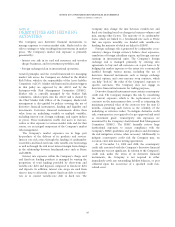American Express 2009 Annual Report Download - page 101
Download and view the complete annual report
Please find page 101 of the 2009 American Express annual report below. You can navigate through the pages in the report by either clicking on the pages listed below, or by using the keyword search tool below to find specific information within the annual report.
NOTES TO CONSOLIDATED FINANCIAL STATEMENTS
AMERICAN EXPRESS COMPANY
The Company’s derivative financial instruments are carried at fair value on the Consolidated Balance Sheets. The accounting for
changes in fair value depends on the instruments’ intended use and the resulting hedge designation, if any, as discussed below.
Refer to Note 3 for a description of the Company’s methodology for determining the fair value of its derivative financial
instruments. The following table summarizes the total gross fair value, excluding interest accruals, of derivative product assets
and liabilities as of December 31:
Other assets
Fair Value
Other liabilities
Fair Value
(Millions) 2009 2008 2009 2008
Derivatives designated as hedging instruments
Interest rate contracts
Fair value hedges $632 $1,072 $6 $—
Cash flow hedges 1—44 125
Foreign exchange contracts
Net investment hedges 132 535 130 165
Total derivatives designated as hedging instruments $765 $1,607 $180 $290
Derivatives not designated as hedging instruments
Interest rate contracts $11 $9$5 $20
Foreign exchange contracts(a) 57 166 95 173
Equity-linked contract(b) ——3—
Total derivatives not designated as hedging instruments 68 175 103 193
Total derivatives(c) $833 $1,782 $283 $483
(a) As of December 31, 2009, foreign exchange contracts also include foreign currency derivatives embedded in certain operating agreements.
(b) Represents an equity-linked derivative embedded in one of the Company’s investment securities.
(c) GAAP permits the netting of derivative assets and derivative liabilities when a legally enforceable master netting agreement exists between the
Company and its derivative counterparty. As of December 31, 2009 and 2008, $33 million and $39 million, respectively, of derivative assets
and liabilities have been offset and presented net on the Consolidated Balance Sheets.
DERIVATIVE FINANCIAL INSTRUMENTS THAT
QUALIFY FOR HEDGE ACCOUNTING
Derivative financial instruments executed for hedge
accounting purposes are documented and designated as such
when the Company enters into the contracts. In accordance
with its risk management policies, the Company structures its
hedges with very similar terms to the hedged items. The
Company formally assesses, at inception of the hedge
accounting relationship and on a quarterly basis, whether
derivatives designated as hedges are highly effective in
offsetting the fair value or cash flows of hedged items. These
assessments usually are made through the application of the
regression analysis method. If it is determined that a
derivative is not highly effective as a hedge, the Company will
discontinue the application of hedge accounting.
FAIR VALUE HEDGES
A fair value hedge involves a derivative designated to hedge
the Company’s exposure to future changes in the fair value of
an asset or a liability, or an identified portion thereof that is
attributable to a particular risk. The Company is exposed to
interest rate risk associated with its fixed-rate long-term debt.
The Company uses interest rate swaps to convert certain
fixed-rate long-term debt to floating-rate at the time of
issuance. As of December 31, 2009 and 2008, the Company
hedged $15.1 billion and $12.4 billion, respectively, of its
fixed-rate debt to floating-rate debt using interest rate swaps.
To the extent the fair value hedge is effective, the gain or
loss on the hedging instrument offsets the loss or gain on the
hedged item attributable to the hedged risk. Any difference
between the changes in the fair value of the derivative and the
hedged item is referred to as hedge ineffectiveness and is
recorded in earnings as a component of other, net expenses.
Hedge ineffectiveness may be caused by differences between
the debt’s interest coupon and the benchmark rate, which is
in turn primarily due to credit spreads at inception of the
hedging relationship that are not reflected in the valuation of
the interest rate swap. Furthermore, hedge ineffectiveness
may be caused by changes in the relationship between
3-month LIBOR and 1-month LIBOR rates, as these so-called
basis spreads may impact the valuation of the interest rate
swap without causing an offsetting impact in the value of the
hedged debt. If a fair value hedge is de-designated or no
longer considered to be effective, changes in fair value of the
99
























